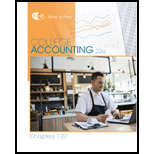
The matching principle in accounting requires the matching of debits and credits.
Identify whether the given statement is true or false.
Answer to Problem 1TF
False statement.
Explanation of Solution
Matching principle: According to this principle, the expense should be recognized when it is actually incurred, doesn’t matter, payment is made or not. This principle ensures that the expenses incurred in the current period are matched against the revenues earned in the same period. Matching principle is sometimes called as expense recognition principle.
The matching principle helps in matching the revenue earned during the year with the respective expense incurred to produce the revenue.
Therefore, for the given statement “The matching principle in accounting requires the matching of debit and credits” is false.
Want to see more full solutions like this?
Chapter 5 Solutions
College Accounting, Chapters 1-27
- Quick Logistics, Inc. had net cash from operating activities of $180,000. It paid $150,000 to purchase new delivery vehicles by signing a $120,000 note and paying the balance. Net cash from (or used for) investing activities for the period was _.arrow_forwardPlease provide the accurate answer to this general accounting problem using appropriate methods.arrow_forwardPlease provide the answer to this general accounting question using the right approach.arrow_forward
- On January 1, 2021, Northstar Innovations purchased equipment for $22,000. The equipment was estimated to have an 8-year useful life and a residual value of $1,200. Straight-line depreciation is used. On January 1, 2023, the equipment was exchanged for a delivery vehicle with a fair value of $18,400. Assuming that the exchange had commercial substance, how much would be recorded as a gain or loss on disposal of the equipment on January 1, 2023?arrow_forwardPlease explain the solution to this general accounting problem with accurate principles.arrow_forwardCan you explain the correct approach to solve this general accounting question?arrow_forward
 College Accounting, Chapters 1-27AccountingISBN:9781337794756Author:HEINTZ, James A.Publisher:Cengage Learning,
College Accounting, Chapters 1-27AccountingISBN:9781337794756Author:HEINTZ, James A.Publisher:Cengage Learning, Cornerstones of Financial AccountingAccountingISBN:9781337690881Author:Jay Rich, Jeff JonesPublisher:Cengage Learning
Cornerstones of Financial AccountingAccountingISBN:9781337690881Author:Jay Rich, Jeff JonesPublisher:Cengage Learning Auditing: A Risk Based-Approach (MindTap Course L...AccountingISBN:9781337619455Author:Karla M Johnstone, Audrey A. Gramling, Larry E. RittenbergPublisher:Cengage Learning
Auditing: A Risk Based-Approach (MindTap Course L...AccountingISBN:9781337619455Author:Karla M Johnstone, Audrey A. Gramling, Larry E. RittenbergPublisher:Cengage Learning- Principles of Accounting Volume 1AccountingISBN:9781947172685Author:OpenStaxPublisher:OpenStax College
 Intermediate Accounting: Reporting And AnalysisAccountingISBN:9781337788281Author:James M. Wahlen, Jefferson P. Jones, Donald PagachPublisher:Cengage Learning
Intermediate Accounting: Reporting And AnalysisAccountingISBN:9781337788281Author:James M. Wahlen, Jefferson P. Jones, Donald PagachPublisher:Cengage Learning College Accounting (Book Only): A Career ApproachAccountingISBN:9781337280570Author:Scott, Cathy J.Publisher:South-Western College Pub
College Accounting (Book Only): A Career ApproachAccountingISBN:9781337280570Author:Scott, Cathy J.Publisher:South-Western College Pub





